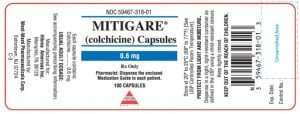High uric acid levels are usually dangerous, but how do you measure high?
Dangers Of High Uric Acid Levels
Many authorities claim that high uric acid levels are no cause for concern if there are no painful swelling symptoms associated with gout. Search for asymptomatic hyperuricemia in the box above right for more information.
Unfortunately, though there is no immediate danger from high uric acid levels, they are a strong indicator that uric acid crystals are starting to grow in your body. In the very early stages, there is little you can do. At the moment, advanced scanning facilities (DECT) are hard to find, so we still have to rely on joint fluid analysis. Unfortunately, early stages of crystal growth are hard to determine as crystals are often too small, or too few, to recognize. For best results, see a rheumatologist at the first signs of joint redness or swelling.
Gout pain, though usually hard to bear, is not dangerous, but uric acid crystals in the body are potentially very dangerous. Once they appear, they grow slowly, and spread throughout the body. They stop tissue from renewing, leading to joint destruction. They also grow into skin, kidneys, heart and all other organs, eventually causing irreparable damage.
High uric acid levels are easy to treat with urate lowering drugs, and borderline cases often respond well to lifestyle improvements. If this is done early enough, long term joint and organ damage can be avoided.
Measuring High Uric Acid Levels
In rheumatology, there is a generally accepted standard that high uric acid levels are anything over 6.8 mg/dL (0.40 mmol/L). This is because, at normal body temperature, harmless soluble uric acid starts to change to dangerous uric acid crystals.
Unfortunately, as I explained in Normal Uric Acid Levels guidelines, family doctors and other non-gout specialists tend to rely on reference ranges that accompany uric acid blood test results. These statistical values often describe high as anything over 8. These statistics have no relevance to gout management.
Describing high uric acid levels in general terms has little value for individual gout sufferers. Once you have gout, or strongly suspect it, the only measurement that matters is your personal uric acid level.
Personal High Uric Acid Levels
There are many personal aspects to high uric acid levels.
To start, the 6.8 standard based on the crystallization point, described above, varies from person to person. The biggest factor is temperature. This tends to be lower in the joints first affected by gout, and joint temperature tends to be lower as you get older.
In the Normal Uric Acid Levels guidelines, I introduced an invaluable book: Interpretation of Diagnostic Tests By Jacques Burton Wallach. He makes the point that comparing test results to personal history is vital to interpreting results correctly. Thus, if you have a history of uric acid levels below 5 mg/dL (0.30 mmol/L) and they suddenly rise to 6 or 7, then this is a cause for concern. Treatment choices depend on individual circumstances, but at a minimum, monthly re-testing is required.
Once you are on a uric acid lowering treatment plan, even one based on lifestyle improvements, the high uric acid levels are simply any value higher than your target level. If you don’t have a target uric acid level, you don’t have a gout treatment plan.
High Uric Acid Levels: What Next
![]() If you do not yet have a clear gout diagnosis, then consider any value above 6 mg/dL (0.36 mmol/L) as high. It might not be high enough to justify uric acid lowering treatment, but it is enough to require regular uric acid tests, and careful monitoring of joints. It is a good opportunity to assess your eating and exercise habits. If these are less than healthy, then lifestyle improvements, together with the all-important uric acid & joint monitoring, may be enough to save you from ever experiencing the agony of gout. See Diet For Gout Sufferers for more detailed advice, or ask in the gout forum.
If you do not yet have a clear gout diagnosis, then consider any value above 6 mg/dL (0.36 mmol/L) as high. It might not be high enough to justify uric acid lowering treatment, but it is enough to require regular uric acid tests, and careful monitoring of joints. It is a good opportunity to assess your eating and exercise habits. If these are less than healthy, then lifestyle improvements, together with the all-important uric acid & joint monitoring, may be enough to save you from ever experiencing the agony of gout. See Diet For Gout Sufferers for more detailed advice, or ask in the gout forum.
If you have a clear gout diagnosis, get a gout treatment plan. This will have different target uric acid levels for different treatment phases. Typically, the long term target is 5 mg/dL (0.30 mmol/L), but your personal circumstances might mean this has to be set at 6. However, during the early months, it is often wise to set a much lower target, say 2 or 3. This encourages old crystals to dissolve faster, which shortens the period of time you are at risk from gout attacks.
Knowing your personal high uric acid level is as important as knowing your current actual level. If you are not sure how to determine either of these values, please ask in the gout forum.
Leave High Uric Acid Levels to browse other Uric Acid guidelines.
High Uric Acid Levels Related Topics
Please remember: to find more related pages that are relevant to you, use the search box near the top of every page.
Common Terms: result, Uric Acid Levels
Other posts that include these terms:
- Colchicine For Gout
- Uric Acid Level Charts
- Uric Acid Levels: Safe or Dangerous?
- What is the purpose of Uric Acid Test?
- How Your Uric Acid Level Changes
- Uric Acid Calculator from Safe to Dangerous
- Uric Acid Concentration Conversion
Please give your feedback
Did this page help you? If yes, please consider a small donation. Your donations help keep GoutPal's gout support services free for everyone.
If not, please tell me how I can improve it to help you more.
- YouTube
- The gout forums.








